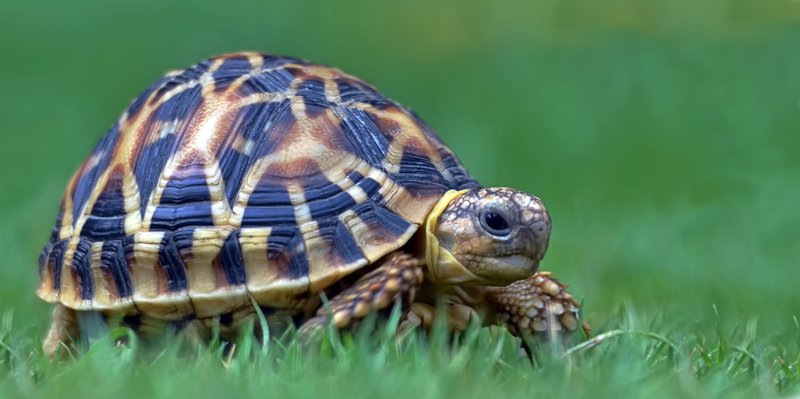
So, how do these tortoises manage to thrive in places where the sun blazes overhead and resources can be scarce? It’s not just luck; it’s a blend of adaptable features and clever survival strategies. Let’s dive into the fascinating ways these tortoises have learned to cope and thrive despite the challenges around them.
Adaptations to Dry Environments
One of the standout features of the Indian star tortoise is its hard shell. This isn’t just for show; this shell serves multiple purposes in the wild. The first benefit is physical protection. It acts as a fortress, keeping the tortoises safe from predators like birds and mammals that might see them as a snack. But it also plays a crucial role in managing water loss.
You see, in dry habitats, staying hydrated is essential. The curved shape of the shell helps the tortoise retain moisture—a crucial aspect of surviving in such an arid climate. The design allows them to stay cooler than if they had a flatter shell, reducing the chances of overheating under the blazing sun. Plus, they can tuck into their shells whenever they need a break from the heat, which is like having a personal air-conditioned shelter when the world gets too hot.
Diet and Foraging Skills
Now, let’s talk about food. You might wonder how these tortoises find sustenance in seemingly barren landscapes. The Indian star tortoise is a herbivore, primarily munching on grasses, fruits, and flowers. However, the ability to find food requires a keen foraging strategy.
These tortoises roam around their habitats, scanning the ground for edible options. They’re pretty selective eaters and prefer nutrient-rich plants. Interestingly, their diets can change with the seasons. During rainy periods, they feast on fresh greens that sprout up, while in dry spells, they can survive on tougher plants. This flexibility in their diet is key to their survival—like having a diverse menu that you can adapt to what’s available.
Water Conservation Techniques
Water is life, especially in the tortoise’s arid homeland. The Indian star tortoise has learned various ways to manage its water intake effectively. Instead of gulping down large amounts of water, they sip small quantities when they come across it. Their bodies are like efficient sponges, allowing them to absorb and store as much moisture as possible.
You might imagine them indulging in a lazy afternoon, drinking from shallow puddles or dew-covered leaves. Moreover, these tortoises can also survive on the moisture contained in their food. By munching on water-rich fruits and greens, they keep their hydration levels in check, which is rather impressive when you think about it!
Burrowing Behavior
Another fascinating aspect of the Indian star tortoise’s survival skills is its burrowing behavior. When the heat becomes too intense or during dry spells, these tortoises dig down into the ground, where temperatures are more moderate. It’s like finding a cool basement in the summer heat.
Their strong legs and sharp claws make digging relatively straightforward. This burrowing habit not only helps them escape the scorching sun but also protects them from potential predators. You might picture them curling up in their self-made shelters, napping the day away while the world bakes above.
Reproductive Adaptations
Let’s take a moment to explore how the Indian star tortoise continues its lineage despite the challenges of its harsh environment. These tortoises have adapted their reproductive strategies to ensure survival. For instance, they often lay their eggs during the rainy season when conditions are more favorable for hatchlings.
The female tortoise can bury her eggs deep in the sand, providing a somewhat insulated environment for them to develop. This strategy helps keep the eggs safe from potential threats like predators while also taking advantage of the moisture in the soil. It’s almost like the tortoises are doing a little rain dance, ensuring that the timing is just right for their little ones to emerge into a world filled with life.
Social Behaviors and Group Living
While Indian star tortoises aren’t known for their bustling social lives, they do display some interesting group behaviors that help them survive. Sometimes, you can find them basking together in the sun, taking advantage of each other’s body heat and sharing resources.
When they gather in groups, it creates a sense of safety. There’s strength in numbers, after all. If one tortoise spots a potential danger—like a hungry predator—others can quickly retreat into their shells. You might think of it as a little community system, where they look out for one another while navigating the tough world they inhabit.
The Indian star tortoise is a fantastic example of how life finds a way to adapt and flourish, even in the harshest environments. From clever water conservation methods to their unique diets and social behaviors, these tortoises have a toolkit of survival strategies that make them truly remarkable.
It’s heartening to see how nature equips creatures, big and small, with the tools they need to face challenges head-on. The next time you spot an Indian star tortoise, remember that it’s not just an adorable reptile; it’s a master of survival, navigating its way through life’s hurdles one slow step at a time.
